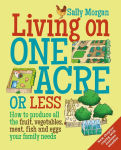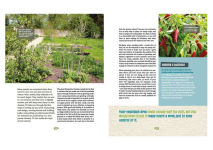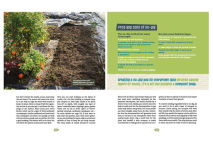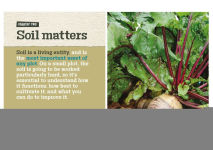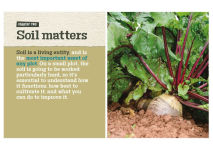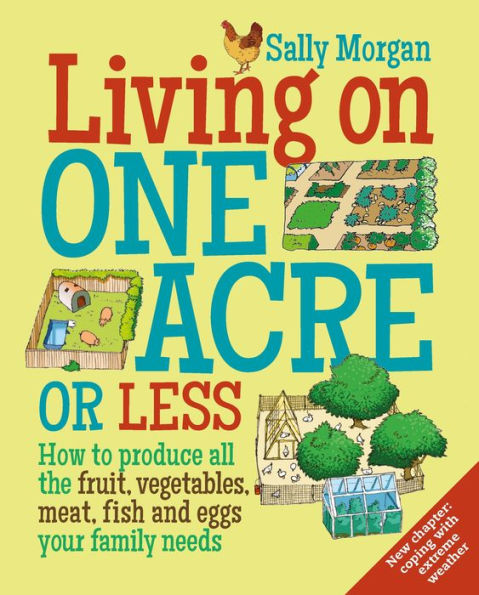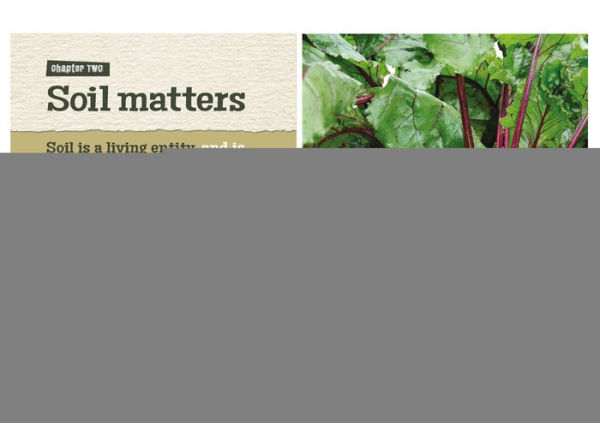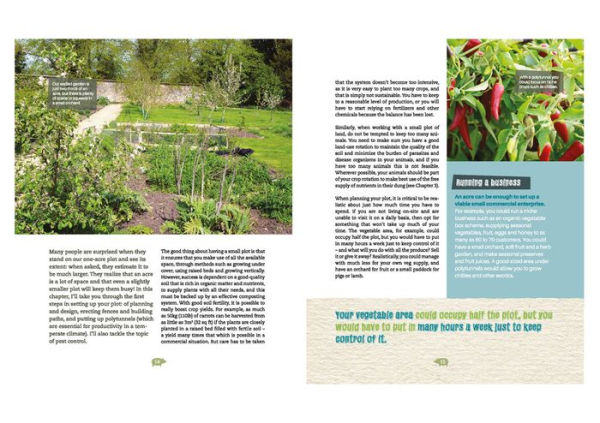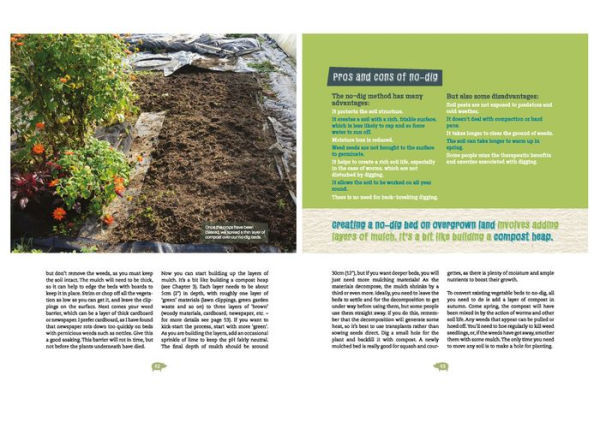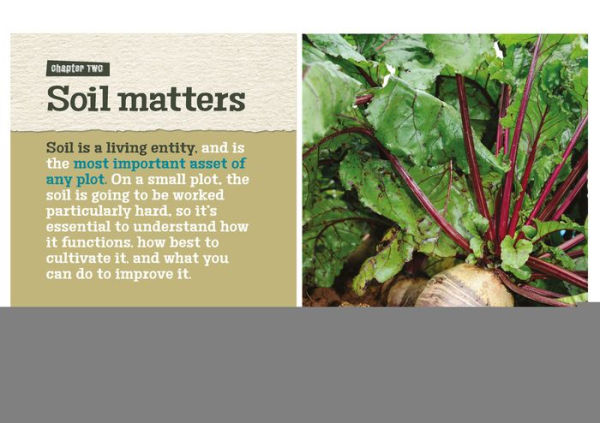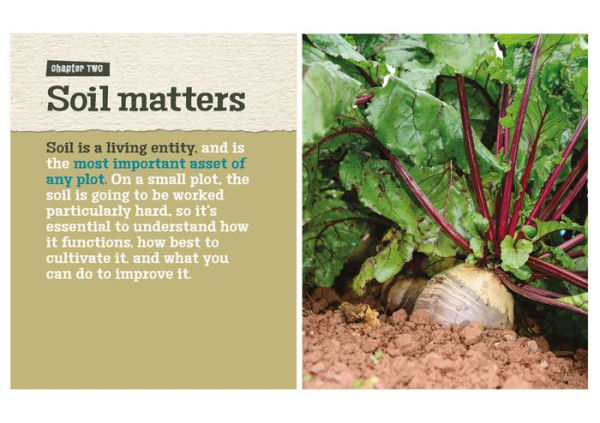Whether you have a garden, a paddock or perhaps the corner of a field, Sally Morgan guides you through:
- How to lay out your plot – including fencing and polytunnels or greenhouses
- Managing soil fertility
- Growing fruit and vegetables throughout the year
- Keeping livestock: poultry, pigs, sheep and goats
- Producing fish with aquaponics
Filled with practical advice, this book is essential reading for anyone who wants to be more self-sufficient and live a more sustainable life.
Whether you have a garden, a paddock or perhaps the corner of a field, Sally Morgan guides you through:
- How to lay out your plot – including fencing and polytunnels or greenhouses
- Managing soil fertility
- Growing fruit and vegetables throughout the year
- Keeping livestock: poultry, pigs, sheep and goats
- Producing fish with aquaponics
Filled with practical advice, this book is essential reading for anyone who wants to be more self-sufficient and live a more sustainable life.

Living on One Acre or Less: How to produce all the fruit, veg, meat, fish and eggs your family needs
224
Living on One Acre or Less: How to produce all the fruit, veg, meat, fish and eggs your family needs
224Paperback
-
SHIP THIS ITEMIn stock. Ships in 3-7 days. Typically arrives in 3 weeks.PICK UP IN STORE
Your local store may have stock of this item.
Available within 2 business hours
Related collections and offers
Overview
Whether you have a garden, a paddock or perhaps the corner of a field, Sally Morgan guides you through:
- How to lay out your plot – including fencing and polytunnels or greenhouses
- Managing soil fertility
- Growing fruit and vegetables throughout the year
- Keeping livestock: poultry, pigs, sheep and goats
- Producing fish with aquaponics
Filled with practical advice, this book is essential reading for anyone who wants to be more self-sufficient and live a more sustainable life.

Product Details
| ISBN-13: | 9780857843302 |
|---|---|
| Publisher: | Bloomsbury USA |
| Publication date: | 03/17/2016 |
| Pages: | 224 |
| Product dimensions: | 8.20(w) x 10.10(h) x 0.90(d) |
About the Author
Read an Excerpt
Living on One Acre or Less
How to Produce all the Fruit, Vegetables, Meat, Fish and Eggs Your Family Needs
By Sally Morgan
UIT Cambridge Ltd
Copyright © 2016 UIT Cambridge Ltd.All rights reserved.
ISBN: 978-0-85784-332-6
CHAPTER 1
Planning your plot
Farming on a small plot is intensive, but in a good way. On even less than an acre you can keep poultry, a couple of pigs, some bees and fish. If you have enough grass, you can raise some lambs or keep goats. And there will still be room for fruit and vegetable plots, sheds and polytunnels.
Many people are surprised when they stand on our one-acre plot and see its extent: when asked, they estimate it to be much larger. They realize that an acre is a lot of space and that even a slightly smaller plot will keep them busy! In this chapter, I'll take you through the first steps in setting up your plot: of planning and design, erecting fences and building paths, and putting up polytunnels (which are essential for productivity in a temperate climate). I'll also tackle the topic of pest control.
The good thing about having a small plot is that it ensures that you make use of all the available space, through methods such as growing under cover, using raised beds and growing vertically. However, success is dependent on a good-quality soil that is rich in organic matter and nutrients, to supply plants with all their needs, and this must be backed up by an effective composting system. With good soil fertility, it is possible to really boost crop yields. For example, as much as 50kg (110lb) of carrots can be harvested from as little as 3m2 (32 sq ft) if the plants are closely planted in a raised bed filled with fertile soil – a yield many times that which is possible in a commercial situation. But care has to be taken that the system doesn't become too intensive, as it is very easy to plant too many crops, and that is simply not sustainable. You have to keep to a reasonable level of production, or you will have to start relying on fertilizers and other chemicals because the balance has been lost.
Similarly, when working with a small plot of land, do not be tempted to keep too many animals. You need to make sure you have a good land-use rotation to maintain the quality of the soil and minimize the burden of parasites and disease organisms in your animals, and if you have too many animals this is not feasible. Wherever possible, your animals should be part of your crop rotation to make best use of the free supply of nutrients in their dung (see Chapter 3).
When planning your plot, it is critical to be realistic about just how much time you have to spend. If you are not living on-site and are unable to visit it on a daily basis, then opt for something that won't take up much of your time. The vegetable area, for example, could occupy half the plot, but you would have to put in many hours a week just to keep control of it – and what will you do with all the produce? Sell it or give it away? Realistically, you could manage with much less for your own veg supply, and have an orchard for fruit or a small paddock for pigs or lamb.
Running a business
An acre can be enough to set up a viable small commercial enterprise.
For example, you could run a niche business such as an organic vegetable box scheme, supplying seasonal vegetables, fruit, eggs and honey to as many as 60 to 70 customers. You could have a small orchard, soft fruit and a herb garden, and make seasonal preserves and fruit juices. A good-sized area under polytunnels would allow you to grow chillies and other exotics.
Planning on paper
Whether you have acquired a greenfield plot or taken over an existing smallholding, it is almost certain that you will need to make changes. It's always best to construct a plan on paper before tackling any work on the site, so you can make decisions on the position of fences, paths and structures such as polytunnels. First, make a scale drawing of your plot showing the boundaries and any existing buildings, and key features such as hedgerows, trees, fences, and water and electric points. Add a compass 'rose' and delineate the shady areas, and indicate the direction of prevailing winds.
Make accurate measurements of the plot before you start. You can do this on the ground, but nowadays it's quicker and easier from the comfort of your desk by using a GPS area measurement app on your smartphone that makes use of Google Earth maps. I checked the accuracy of one of these apps and found it to be accurate to within 0.5m (1'8"), which is perfectly adequate for a plan. There are apps that will measure the height of objects – another useful feature if you have trees, buildings or a tall hedge nearby. It is useful to know the height of objects such as trees, as you can then work out the shelter effect. A windbreak is effective for up to six times its height, so a 3m (10') hedge on the prevailing wind side of your plot will give 18m (about 60') of shelter. Drones, too, can be useful: you can use one to take an aerial photo of the site, as shown in the photos below.
Planning checklist
The following are key points to consider when making your plan.
Decide on an access point if there is not an obvious one already (check the planning regulations); the size of gates and whether you need a hard-standing or turning area.
Decide on the type of boundary you need (fence or hedge), and whether you will need windbreaks (rows of willow, poplar or Jerusalem artichokes, for example).
A slope will restrict what you can do, and you'll need to plan carefully to avoid soil erosion, with terraces across the slope rather than exposed areas on the slope. You may want to dig swales (ditches) along the contour lines to slow down and capture water run-off. Before you do anything, go out during heavy rain and observe how the water runs off your land.
Think about the size and position of the more permanent structures such as sheds and polytunnels, which will need good access, will create shade and will generate some water run-off.
Consider security carefully, especially if your site is visible from a road or footpath.
Where will be your main routes through the plot? These will be formed between the various points that you need to access, and the type of route may depend on the frequency of use (see also 'Zoning', below). How many paths will you need and how wide do they have to be?
Where will your water come from? Are you going to have pipes and taps or will you collect water from roofs? Do you need a dipping pond or a water tank?
Where will you build your vegetable beds? They will need an open, sunny location, which should be flat if possible. The best orientation for the beds is north–south, so all plants get the same amount of sunlight and do not shade each other. If the orientation is east–west, then there will be some shading.
Mark out the area that you will use for permanent crops, including fruit trees and soft fruits. Do you want an orchard, or will you plant fruit and nut trees across the plot? Do you have space for a fruit cage?
Where will you build your compost bins? You will need space to wheel in the green waste and turn the compost. Don't forget that you will be barrowing the finished compost on to the vegetable beds, so it needs to be close to them and not down a slope!
Do you want to grow willow or poplar for fuel or to include a forest garden?
Make a list of all the animals you want to keep, and work out the area of land you need for them. Remember that you may need trailer access for transporting pigs, bringing in chicken houses or moving fencing materials, etc. Read the advice in Part Three before making these decisions.
Once you have a rough plan, check that you have made best use of all the space. Can you add an edible hedgerow, or plant cordon or espalier fruit trees along the boundaries? Have you collected all the water that may be available to you? Do you have enough space for animals and options for rotating their pasture?
Before you get carried away and start planting trees and buying livestock, it is absolutely critical to get the site layout right, because paths, fences and buildings are expensive to put in and can't be moved easily. The first step is to plan your boundary fencing if there is none in place or if what is there is unsuitable; this is particularly important if you want to keep livestock. You'll need to decide what type of paths you want and their routes, and the location and type of any large enclosures and any structures such as polytunnels and sheds, before going on to site smaller things such as your planting areas and compost heaps. Check the local planning rules regarding sheds and polytunnels.
Zoning
When designing your plot, it is useful to think of 'zones': a permaculture principle based on the number of visits an area will receive on a daily basis. If you will be visiting an area very frequently, it makes sense to locate it near to your access point (if you are living on-site then your access point in this sense will be your house). Broadly speaking, you can imagine different zones as concentric circles or sectors, spreading out from the access point. However, zones should not be defined rigidly, as there may be other constraints on your site, such as slope and aspect, that determine where something will be sited, and you can also have a zone appearing more than once on your plan.
Zone 1 describes those areas that need the most frequent visits, in order to water, tend and harvest, so these are generally positioned closest to the access point. They might include the polytunnel, cold frames, shed, aquaculture unit, and vegetable beds and wormeries.
Zone 2 will be areas that receive less frequent daily attention, such as the chicken and pig pens, where the animals still need checking twice a day but are less intensively managed than in zone 1.
Zone 3 is the areas that will not require daily visits, such as the orchard, fruit cage, perennial beds, composting bins and crops that need less attention, such as squash; plus your bee hives. You might include your sheep and goats in this zone, although they will require two checks a day.
Zone 4 might include your forest garden, willow for fuel plot, and carp ponds.
Zone 5 will be your wild areas that are rarely visited, so are often located near the furthest boundaries.
The edge effect
It is well known that in nature the most biodiverse and productive areas are those in the overlap zone between two ecosystems: for example, in the intertidal zone along coasts, where the open ocean meets land; in mangrove forests along tropical coastlines; where forest meets grassland; and in woodland clearings. This is because in these areas there is a greater range of conditions, allowing more species of plants to survive, which in turn supports a greater diversity of animals. If you can incorporate more 'edges' in your plot, you will create lots of different microclimates and a richer ecosystem. For example, I like to have small log piles, where beneficial predators such as beetles and spiders can hide, and I let the grass grow long in places as this attracts different animals. If you are planning a forest garden (see Chapter 6), include a small glade or clearing that aligns north to south. It will have its own microclimate, being sheltered from extremes by the trees all around it, with (in the northern hemisphere) the northern end getting plenty of sunlight from the south. Another way of creating more edge is simply to have wavy edges rather than straight lines between areas. A curved path has more edge than a straight path, while a keyhole or a spiral bed are more varied in microclimates than a rectangular bed.
A water feature
A small pond on the plot will attract useful animals, such as frogs and toads and possibly grass snakes, and provide drinking water for mammals such as hedgehogs. It doesn't have to be large, and could perhaps be sited in a quiet corner where the wildlife won't be disturbed. If you are harvesting water on the site, any overflow water could be directed into the pond. In our walled garden, water from one of our barns is directed into a dipping pond, and from there any overflow goes into a large duck and carp pond (see Chapter 10). The water in the dipping pond is enough to water the vegetable beds all summer, and it's quick and easy to fill a bucket with water, so a hose is unnecessary.
Fencing
There are various factors to consider when deciding on the location of a fenced pasture. The shape makes a big difference to the length of fence required for a given area: the squarer it is, the less fence you need. Avoid any acute corners, as they are awkward to get into with machinery. Shade, slope, access to water and the type of livestock are also key factors. The priority must be fences along roads and around areas from which livestock must be excluded or contained: these will normally be fixed or permanent fences. Paddocks can be subdivided with temporary fences, such as flexi-nets to change the grazing areas and to respond to changes in grass availability.
Stock fencing
Stock fencing is a long-term, permanent option, and (as the name suggests) is used to contain livestock. It comes in a range of sizes, with different heights and mesh patterns to suit different animals, and can be used with two additional lines of wire to increase the height of the fence. The netting is fixed to either round or half-round stakes and is supported at ends, at corners and at every change of direction by straining posts, which have bracing struts for additional strength. If you are fencing in pigs, which take great delight in digging under unprotected fencing, it is best to add a single strand of electric fencing along the bottom on the inside.
Positioning posts for stock fences
Setting posts correctly is one of the most important factors in fence strength. The correct depth depends on the diameter of the post and your soil type. Generally, in medium to heavy clay soils, a post is placed at a depth equal to 10 times its diameter. In sandier soils, the depth should be 15 times the diameter. At these depths, the post would break before it uproots. The spacing of posts varies with the fence type and the lie of the land. Posts are usually positioned every 3m (10'), but where the land slopes, posts are placed at the top and bottom of the slope to ensure the fence follows the contours.
Electric fencing
Electric fencing is the quickest and most cost-effective way to contain livestock. It is easy to install and repair, and usually requires fewer posts than stock fencing. Electric fence can be temporary or permanent. You will need reels of wire or tape or netting, posts, insulators, an energizer, and a power source such as a 12V battery or access to mains power. Such electric fences require no tools for set-up, minimal bracing, and use lightweight plastic line posts.
Electric fences, whether portable or permanent, use galvanized wire, polywire or polytape to transmit the shock. Polywire is a braided or twisted polyethylene cord with three, six or nine strands of stainless-steel wire running through it. Polytape, as the name suggests, is a woven flat polyethylene tape, also with several wires running through it. It is more visible than polywire, and it tends to flutter in the wind, making it easy for animals to spot and avoid. It is the wire that carries the electricity in both polytape and polywire, so the more strands the better: nine is best, six is adequate, but avoid three. I prefer to use galvanized wire because, even though it is a little harder to handle, it is much more effective electrically (it is easier to get a good join and has less electrical loss).
It is almost always best to use galvanized wire for permanent electric fencing and for fencing around pigs, though we often add a polytape top line so that animals and humans can easily see the fence (See Chapter 8, page 169). Due to the long lengths of wire, reels are an essential part of putting out and retrieving electric fences. If fences are to be erected and dismantled regularly, it may pay to invest in a geared reel.
Permanent electric fences will need either wood or steel corner posts with insulators, though you can still use plastic intermediate line posts. Whether wood or plastic, the line post needs to be rigid enough to withstand wind but flexible enough to bend under excessive pressure. It is important to keep the fence free of vegetation, so you can either strim under the fence regularly or, to avoid this necessity, place a strip of ground-cover fabric along the line of the fence. At gateways you can put the wire in a length of piping, so people can step over it safely, or use sprung coils of wire to create a removable barrier.
Remember that you should put warning signs on the fence if it is somewhere the general public could come into contact with it, such as beside a footpath.
Flexi-nets
One option for poultry and sheep is flexible electric netting. It usually comes complete with plastic posts and a mains- or battery-powered battery unit, and can be moved from place to place quite easily and rolled up when not needed. It comes in different heights and is generally sold in lengths of 25m or 50m (82' or 164') with gates. A 50m roll creates a pen of approximately 156m2 (1,680 sq ft). The difficulty with this form of netting, however, is keeping the bottom strands free of vegetation. Although it can be used as an external perimeter for sheep, it is better as an internal barrier or divider in a stock-fenced field.
(Continues...)
Excerpted from Living on One Acre or Less by Sally Morgan. Copyright © 2016 UIT Cambridge Ltd.. Excerpted by permission of UIT Cambridge Ltd.
All rights reserved. No part of this excerpt may be reproduced or reprinted without permission in writing from the publisher.
Excerpts are provided by Dial-A-Book Inc. solely for the personal use of visitors to this web site.
Table of Contents
IntroductionPart One: Design & groundwork
1. Planning your plot
2. Soil matters
3. Soil fertility & crop rotations
Part Two: Growing produce
4. The vegetable & flower garden
5. An abundance of fruit
6. Tree crops & forest gardens
Part Three: Keeping livestock
7. Poultry for eggs & meat
8. Pigs for meat
9. Including sheep or goats
10. Aquaponics
11. Beekeeping
Appendix: Livestock regulations & good practice
Resources
Index
